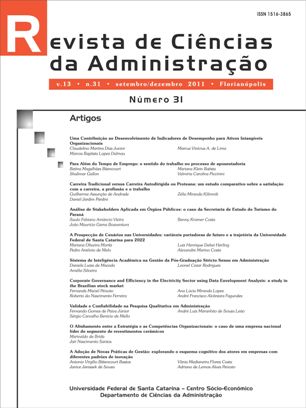A contribution for the development of performance indicators of the organization intangible assets
DOI:
https://doi.org/10.5007/2175-8077.2011v13n31p11Abstract
DOI: 10.5007/2175-8077.2011v13n31p11
This paper classifies management models whose original concepts are used and adapted as a way to raise awareness of the importance of internal intangible assets of Methodologies considered for this purpose are as follows, the methodology of Teixeira (2005) to determine the manufacture flexibility indicators, the methodology of França (2004) to establish indicators for the organizational intangible assets and the methodology and the Hoss (2003) for quantity and quality valuation of intangible assets which are analyzed. An adaption of these methodologies is thus proposed so that they may be customised for the utilization of the knowledge assets. The primary aim of the work presented in this paper, is to be able to assess the real value of the organizational intangible assets and the development of performance indicators for these same assets, in order to obtain better levels of operational efficiency in the management of the industrial context within the a unit manufacture.
Downloads
Published
How to Cite
Issue
Section
License
The author must ensure:
- that there is complete consensus among all co-authors to approve the final version of the paper and its submission for publication.
- that their work is original, and if the work and/or words of others have been used, these have been duly acknowledged.
Plagiarism in all its forms constitutes unethical publishing behavior and is unacceptable. RCA reserves the right to use software or any other methods of plagiarism detection.
All submissions received for evaluation in the RCA journal are screened for plagiarism and self-plagiarism. Plagiarism identified in manuscripts during the evaluation process will result in the submission being archived. In the event of plagiarism being identified in a manuscript published in the journal, the Editor-in-Chief will conduct a preliminary investigation and, if necessary, retract it.
Authors grant RCA exclusive rights of first publication, with the work simultaneously licensed under the Creative Commons (CC BY) 4.0 International License.

Authors are authorized to enter into separate, additional contractual arrangements for the non-exclusive distribution of the version of the work published in this journal (e.g., publishing in an institutional repository, on a personal website, publishing a translation, or as a chapter in a book), with an acknowledgement of its authorship and initial publication in this journal.
This license grants any user the right to:
Share – copy, download, print, or redistribute the material in any medium or format.
Adapt – remix, transform, and build upon the material for any purpose, even commercially.
According to the following terms:
Attribution – You must give appropriate credit (cite and reference), provide a link to the license, and indicate if changes were made. You may do so in any reasonable manner, but not in any way that suggests the licensor endorses you or your use.
No additional restrictions – You may not apply legal terms or technological measures that legally restrict others from doing anything the license permits.


